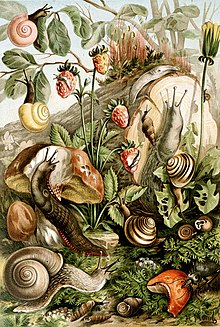| Pulmonata Temporal range: | |
|---|---|
 | |
| Various examples of Pulmonata | |
| Scientific classification | |
| Domain: | Eukaryota |
| Kingdom: | Animalia |
| Phylum: | Mollusca |
| Class: | Gastropoda |
| Subclass: | Heterobranchia |
| Informal group: | Pulmonata Cuvier, 1814 |
| Taxonomic subdivisions | |
| |
Pulmonata or pulmonates is an informal group (previously an order, and before that, a subclass) of snails and slugs characterized by the ability to breathe air, by virtue of having a pallial lung instead of a gill, or gills. The group includes many land and freshwater families, and several marine families.
Contents
- Linnean taxonomy
- 2005 taxonomy
- Informal Group Pulmonata
- 2010 taxonomy
- References
- Further reading
- External links
The taxon Pulmonata as traditionally defined was found to be polyphyletic in a molecular study per Jörger et al., dating from 2010. [1]
Pulmonata are known from the Carboniferous period to the present. [2]
Pulmonates have a single atrium and kidney, and a concentrated symmetrical nervous system. The mantle cavity is on the right side of the body, and lacks gills, instead being converted into a vascularised lung. Most species have a shell, but no operculum, although the group does also include several shell-less slugs. Pulmonates are hermaphroditic, and some groups possess love darts. [3]


